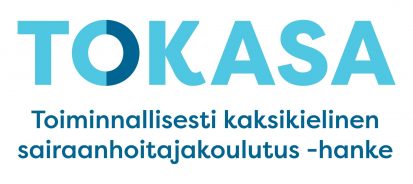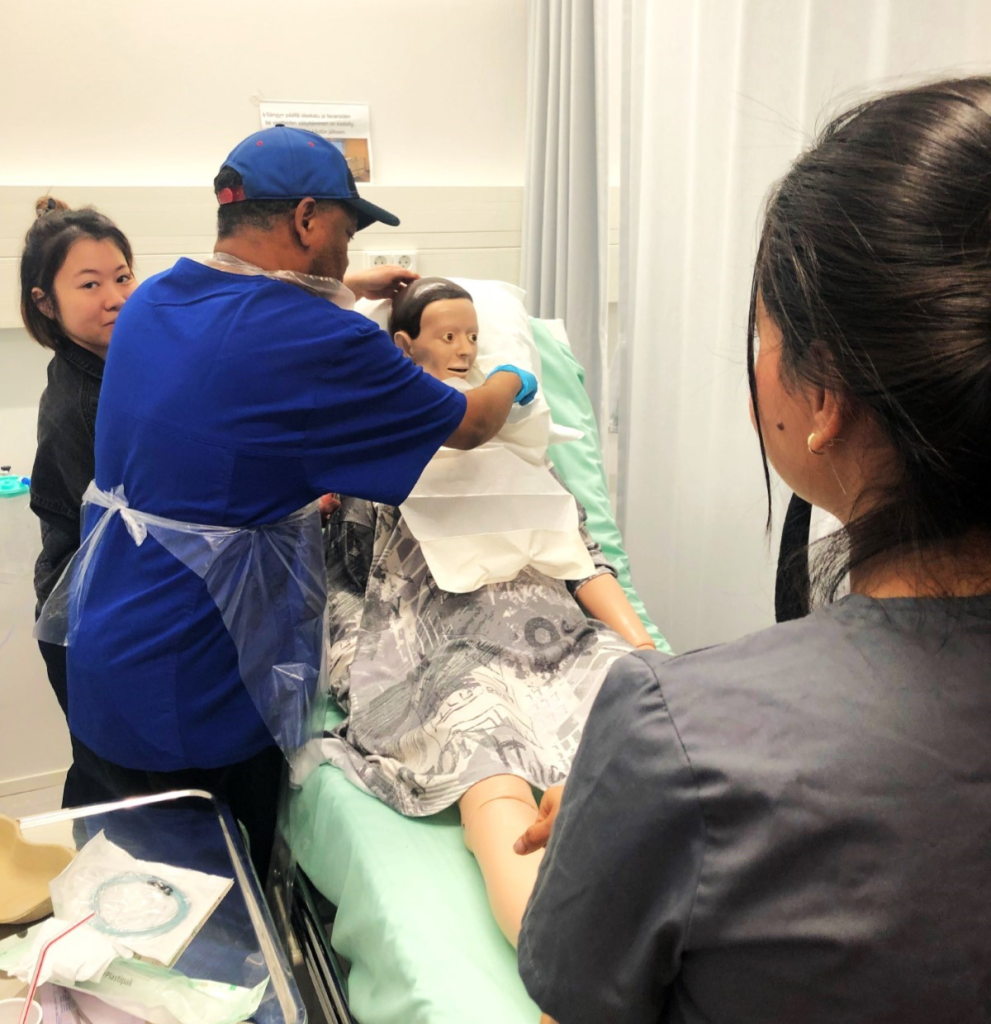Hoitotyön potilasohjausta harjoittelemassa
Potilaan kohtaaminen ja ohjaaminen ovat sairaanhoitajan työn ydinsisältöä. Ne ovat myös korostetun kielellisiä toimintoja, joiden harjoittelemista opiskelijat toivovat sitä hartaammin, mitä pidemmälle opiskelu etenee.
Järjestimme TAMKissa syksyllä 2024 Hoitotyön ohjaustilanteet suomeksi -opintojakson, jossa opiskelijat pääsivät harjoittelemaan keskeisiä ohjaustilanteita esimerkkitilanteiden kautta. Mukana kurssilla oli TOKASA-opiskelijoiden lisäksi Sairaanhoitajien laillistamiskoulutuksen opiskelijoita, joten samalla saatiin vaihtelua oman ryhmän kanssa toimimiseen. Kurssille osallistuneet TOKASA-opiskelijat ovat jo opintojensa loppusuoralla, joten tilanteet olivat hoitotyön näkökulmasta jo tuttuja, ja nyt päästiin keskittymään ohjaamiseen erityisesti kielen näkökulmasta. Ohjaustilanteita harjoitellaan TOKASAssa useilla opintojaksoilla niiden sisään suunnitelluissa suomen kielen integraatioissa, mutta nyt oli mahdollisuus päästä vielä kerran harjoittelemaan niitä konkreettisella tasolla ja ohjatusti. Työpajojen aiheiksi yhteistyössä hoitoalan opettajien kanssa valittiin potilaan haastattelu ennen leikkausta, potilaan ohjaus ennen leikkausta ja sen jälkeen, lääkehoito ja ABCDE-protokolla.
Kurssi jakautui näiden neljän teeman ympärille niin, että ensin pidettiin kahden tunnin mittainen sanastopaja, jonka jälkeen oli neljän tunnin mittainen toiminnallinen työpaja. Ensimmäisessä pajassa valmistauduttiin varsinaiseen työpajaan käymällä läpi ohjaustilanteisiin liittyvää sanastoa ja vuorovaikutustilanteita. Mitä asioita vuorovaikutuksessa tulee huomioida? Mikä on kielellisesti tärkeää? Millaisia asioita hoitajan tulee osata kertoa tilanteissa? Millaisia kysymyksiä potilaat voivat esittää? Esimerkkitilanteista oli olemassa suomen kielen opettajien tekemiä valmiita tehtäviä, haastattelurunkoja ja dialogeja, joita kuunneltiin ja analysoitiin johdatteluna teemaan. Toiminnallisessa työpajassa opiskelijat itse kehittivät potilaskohtaamistilanteita käytännön esimerkkien avulla. Mahdollisuuksien mukaan pajoissa oli paikalla S2-opettajan lisäksi hoitotyön opettaja, jolloin opiskelijat saivat tarvittaessa tarkistaa hoitoalaan liittyvät asiat häneltä.
Toiminnalliseen työpajaan hoitoalan opettaja laati muutamia tapausesimerkkejä, jotka jaettiin opiskelijoille. Tapausesimerkeistä kävi ilmi esimerkiksi potilaan ikä ja tausta, käytetty lääkitys, hoitoon hakeutumisen syy ja lähiomaisten tiedot. Esimerkkipotilaista annettu informaatio vaihteli työpajan teeman mukaan. Saatuaan oman esimerkkipotilaansa opiskelijat laativat pareittain dialogin, jossa potilas ja hoitaja keskustelevat potilaan tilanteesta. Dialogissa oli tärkeää käydä läpi kaikki tilanteessa olennaiset kysymykset ja huomioida kustakin potilaasta saatu taustatieto. Kun dialogi oli valmis, opiskelijat harjoittelivat dialogin esittämistä. Lopuksi opiskelijat vielä kuvasivat oman dialoginsa ja lähettivät siitä linkin ryhmän yhteisen oppimisalustan keskustelualueelle. Jokainen pari katsoi vähintään yhden toisen parin dialogin ja kommentoi sitä.
Opiskelijoilta tuli kurssin aikana positiivista palautetta uudenlaisesta opintojaksosta. Jo aiemmin on tullut toiveita suomen kielen harjoituksista, joissa toistuisivat mahdollisimman autenttiset potilastilanteet. Sanastopajoissa pyrittiinkin aina kuuntelemaan jokin dialogi teemaan sopivasta aiheista. Dialogeja on tuotettu TAMKissa sekä TOKASAssa että muissa sairaanhoitajien suomen kielen taidon kehittämiseen liittyvissä projekteissa. Kuuntelemisen lisäksi teemat kertautuivat monella eri tavalla: lukemalla, kirjoittamalla ja itse puhumalla. Toistensa dialogeihin tutustumalla opiskelijat pääsivät vielä laajentamaan aihetta eri potilaan näkökulmasta.
Opiskelijat kaikki olivat olleet jo useammalla harjoittelujaksolla, joten tilanteet olivat heille kokemuksellisesti tuttuja, mutta luokkahuone ja tutut kurssikaverit ja opettajat loivat suomen kielen harjoittelulle turvallisen ja rohkaisevan ympäristön. Vuorovaikutustilanteiden harjoittelemiselle varattiin myös reilusti aikaa. Opiskelijaryhmässä kaikki olivat tasavertaisessa oppijan asemassa, jolloin harjoittelu vertaistuen ja palautteen avulla tuntui mielekkäältä. Tarve tämäntyyppiselle opintojaksolle on huomattu työharjoitteluissa, joissa potilaan kohtaamistilanteet ovat keskeisessä roolissa. Puhetaitojen harjoittelua ei voi opetuksen arjessa olla liikaa, ja se tuo lisää varmuutta myös kielen käyttämiseen työharjoittelussa.
Kirjoittajat ovat TAMKin S2-lehtorit Ella Hakala ja Terhi Tapaninen

